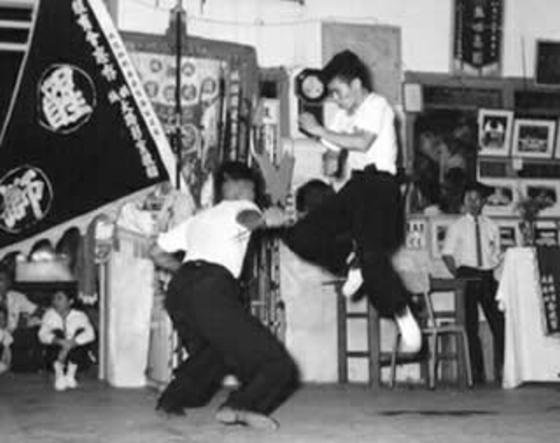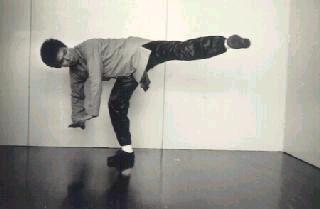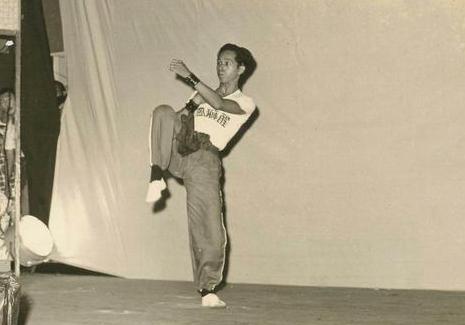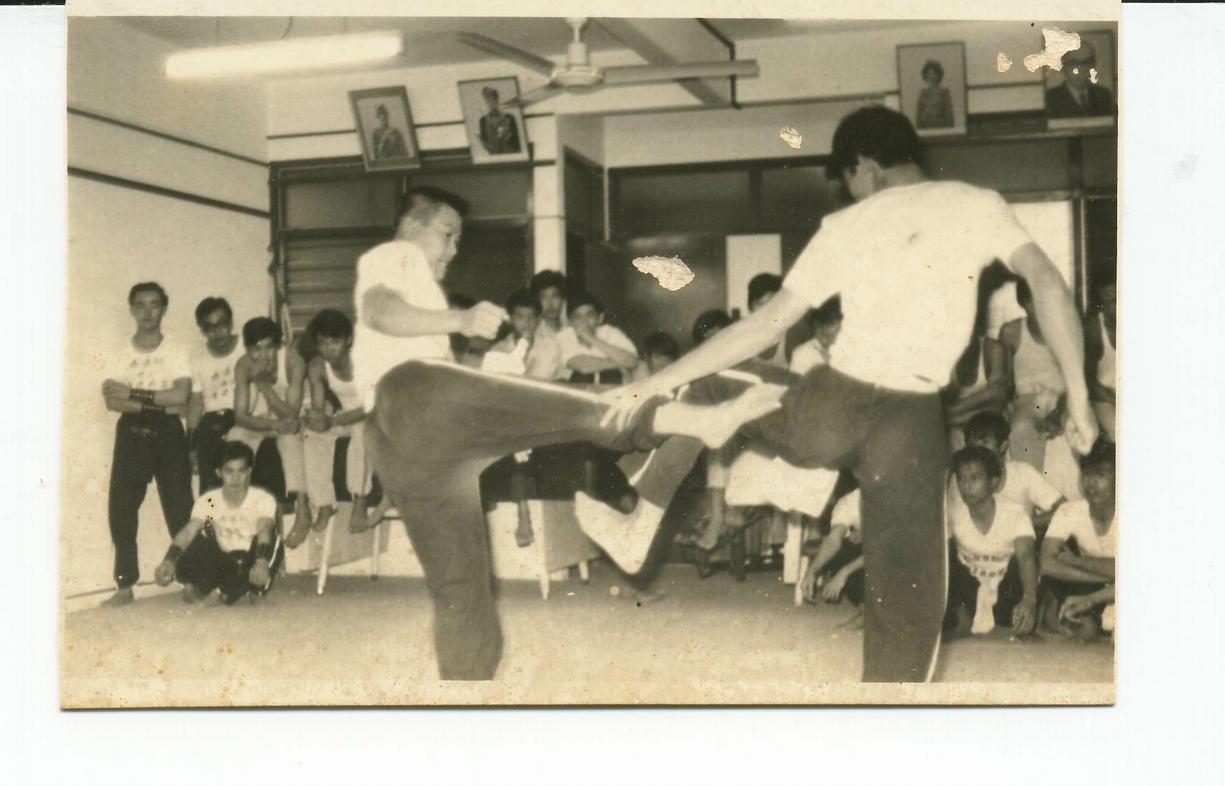SELECTION OF QUESTIONS AND ANSWERS
JANUARY 2013 PART 1

Uncle Righteousness and young Grandmaster Wong sparring in a public deonstration
Question 1
Sigung Lai was a great fighter and Shaolin master. How was it that you only learned "flowery fists and embroidery kicks" from him? Were his more senior students (did he actually have any more advanced than you) also great fighters?
— Sifu Andrew Barnett, Chief Instructor, Shaolin Wahnam Switzerland
Answer
There was no doubt my sifu, Sifu Lai Chin Wah, was a great fighter. His honourable nickname, Uncle Righteousness, by which he was better known in kungfu circles than his own name, was not just due to his sense of righteousness, but due to his frequent actual fighting to maintain righteousness.
The main reason why I learned only "flowery fists and embroidery kicks" from a great fighter despite being his most favourite disciple was the way kungfu was taught by all masters at this time.
As recent as a hundred and fifty years ago, about the time of Wong Fee Hoong and Huo Yuan Jia (late 1800s and early 1900s), kungfu was for fighting. People learned kungfu not for health, not for spiritual cultivation but to be able to fight well. And fighting was common then.
But soon kungfu deteriorated into "flowery fists and embroidery kicks". Apart from the introduction of firearm as well as law-abiding society, which made kungfu fighting obsolete, two events in kungfu history, which are not widely known, contributed to a rapid decline of kungfu combat efficiency.
One was rich men inviting kungfu masters to their family to teach their children, and the other was kungfu masters opening schools to the public. The common factor was that kungfu masters depended on students' fees for living.
Rich men's children did not make good kungfu students, and mass teaching resulted in poor standard. The result was that kungfu masters focused on teaching forms, which gave students a false sense of progress, rather than focusing on developing force and combat application, which were actually the pillars of kungfu training.
Hence, by the time I learned kungfu from Uncle Righteousness, teaching kungfu sets was the norm. There was no formal emphasis on force development and combat application. This is still the norm today, except for a later change which I shall presently describe.
Hence, as a general rule, today if someone boasts that he has learnt kungfu for 20 years from Chinese masters of established lineages in Hong Kong, Taiwan or any Southeast Asian countries or even in mainland China, we can safely conclude that he can only demonstrate beautiful kungfu forms in solo, what past masters referred to as "flowery fists and embroidery kicks".
About 50 years ago (about 1960s) Karate, Taekwondo and later Muay Thai became popular. Their focus was on free sparring. When kungfu practitioners sparred with these martial artists, the kungfu practitioners were rudely awaken to their combat inadequacy. Some enterprising kungfu masters, therefore, started adopting these other martial art techniques into their training. The result was what we have today -- using kungfu forms in solo demonstration but kick-boxing in sparring.
Meanwhile in mainland China, traditional kungfu was transformed to modern wushu, which is magnificent to watch but never meant for combat or spiritual cultivation. In their effort to bring back combat efficiency, wushu instructors also introduce kick-boxing into their combat training. The result was Sanda, which originally meant free sparring using kungfu forms but now it connotes Chinese Kick-Boxing.
Hence, the great majority of kungfu practitioners today fall into one of the following five categories:
- Traditional kungfu forms but no combat training.
- Traditional kungfu forms with kick-boxing for combat training.
- Modern wushu forms with no combat training.
- Sanda using kick-boxing for combat training, with wushu forms for solo demonstration
- Sanda using kick-boxing for combat training, without wushu forms for solo demonstration
Our school is a very rare minority, using traditional kungfu forms for combat training, but we place priority on enriching our daily life over beating other people in fighting. This, we believe, was what Shaolin Kungfu and Taijiquan were originally for.
To say that my classmates and I learned "flowery fists and embroidery kicks" from Uncle Righteousness was actually an over-statement. Although force training and combat application were not emphasized the way we now do in Shaolin Wahnam -- these were a legacy from my other sifu, Sifu Ho Fatt Nam -- relatively my classmates and I had more internal force and were more combat efficient than students from most other kungfu schools.
This, I believe, was due to two reasons. In his teaching, Uncle Righteousness placed much emphasis on stance training and picture-perfect form, which respectively gave us internal force and technical advantages, two favourable requisites for successful combat.
Secondly, because Uncle Righteousness was a great fighter himself, his fighting ability sort of rubbed onto us. Although we were not actually tested, as we then lived in a law-abiding society unlike Uncle Righteousness' time, my classmates, most of whom were senior to me in chronological age but not in kungfu age, were usually regarded as good fighters -- just because we were Uncle Righteousness' students.
Later I had a chance to test out my fighting ability with other people, both kungfu practitioners as well as other martial artists. I actually went round to search for people to fight with -- in a friendly and respectful way. This was before I learned from Sifu Ho Fatt Nam.
Although I did not win every match, I was never beaten. This was due not so much to my fighting ability but to my being smart. I chose to fight those whom I had confidence in beating. In this way I built my fighting experience and fighting ability. Herein lay the seeds of our scholar-warrior concept of victory before actual combat and systematic progress in our 30-opponent programme.
My training with Sifu Ho Fatt Nam brought my internal force and combat efficiency to a totally new and incredible level. When I sparred with others, including kungfu masters and masters of other styles, I could beat them comfortably. At the time I was learning from Uncle Righteousness, there were classmates who were more advanced than me in kungfu performance, but later by their own admission as well as actual sparring, I surpassed them.
Question 2
Sigung Ho was a great Shaolin master and also a very powerful Taoist master. How much of his Taoist mastery and skill set is to be found in Shaolin Wahnam, and, if so, where? Are there any special Taoist skills you learnt (and could/would pass on) from Sigung Ho?
Answer
Yes, my sifu's Taoist teaching has influenced and benefited us in Shaolin Wahnam. But the influence and benefit of his Zen teaching is more by a big margin. It is quite interesting. Only a few close to him knew he was a Zen master. The public knew him as a great Taoist master.
In the spirit of Zen, though, he did not mention this at the time. My sifu did not distinguish Taoist or Zen teaching from others of his teaching. He just taught according to expedient needs or his planned aspirations. Much of the teaching was informal, like over meals and by his examples. But with hindsight, I can now pick out some of the Taoist concepts, skills and techniques transmitted to me.
The Taoist concept that is most outstanding is yin-yang harmony. My sifu did not explained yin-yang harmony to me in a formal way, but with hindsight it was outstanding in all his teaching. For example, my sifu was a highly spiritual person, but he thoroughly enjoyed life in the phenomenal world. The influence and benefit is clearly practiced in our school now.
Yin-yang harmony, a crucial concept in Taoist philosophy, is found in every aspect of our life. We are combat efficient yet we have good health, vitality and longevity. We cultivate internally, yet we pay attention to picture-perfect form. We perform well in business, profession and society, yet we value family life, personal friends and private solitude.
Following the flow is an important Taoist skill. When my sifu saw me performing Four Gates in a staccato manner, he told me to perform various patterns in a sequence, completing in one breath. This introduced me to the Taoist skill of flow, which later enriched my performance in chi kung, kungfu as well as in life.
In Shaolin Wahnam, its influence and benefit can be seen in many places. When we perform Lohan Asks the Way in four breaths, or any combat sequence in one breath, we are benefiting from this Taoist skill of flow. In sparring when we respond spontaneously and correctly using appropriate kungfu techniques to an opponent's attack, we are employing this skill of flow.
On another occasion, my sifu showed me how he taught a Sultan the Shaolin Bagua Set in a flowing manner, different from how I performed the set at that time in a hard, powerful way. This introduced me to energy flow which developed into internal force.
This skill is now found in all our exercises, to the extend that every movement in our practice is a training of energy and mind, and that some people, due to their limited experience, wonder how our art can be called Shaolin Kungfu when we do not use mechanical strength. It also enriches our practice of Wahnam Taijiquan.
The Drunken Eight Immortals, loved by many of our Shaolin Wahnam practitioners, is another outstanding Taoist influence and benefit from my sifu. He only taught me a typical pattern of each of the eight Immortals.
The Drunken Eight Immortals Set we now practice in Shaolin Wahnam was composed from a combination of these signature patterns and another Drunken Eight Immortals Set I learned from my Wing Choon teacher, Sifu Choe Hoong Choy. Our Drunken Eight Immortals Set has greatly enriched the repertoire of our combat application, especially in felling and floor work.
Small Universe is regarded as the most advanced of Taoist chi kung. My sifu did not tell me that it was Small Universe. He started by teaching me Abdominal Breathing, and later Reversed Breathing. It was much later, after diligent practice of about a year, that I attained the Small Universe. It is incredible that our students now, when they have sufficient foundation, can attain the Small Universe in a few days. Arts related to the Small Universe, like Abdominal Breathing and Dan Tian Breathing, are the result of this Taoist influence and benefit.

Picture-perfect form, as demonstrated here in a tiger-tail kick by young Grandmaster Wong, was a hallmark of Uncle Righteousness' teaching
Question 3
In Taoist development, the ultimate aim is immortality. I have read that many Taoist masters trained for hours every day to attempt to achieve this -- even to the point of neglecting to lead a "normal" life. What I don't understand is why. To become immortal seems like a relatively mundane achievement except for egoistic reasons. Do you have any insights you could share on this?
Answer
Attaining immortality is not by any means a small achievement. It is the ultimate achievement in Taoist practice. Hence, Taoist masters are ready to forego worldly pleasures to become recluses so as to cultivate whole-heartedly for this attainment.
This Taoist approach is different from Zen. Taoists, including those who have achieved high office and fame, renounce society to enter solitude so as to cultivate for spiritual fulfilment. Zen practitioners enter society and serve society but without being contaminated by it, while cultivating to attain spiritual fulfilment.
Attaining immortality may be interpreted at three levels.
- To live a healthy, long life in this world.
- To become an immortal to roan the heavens.
- To attain the Tao, called variously by people of different religious or cultural background as attaining Enlightenment or returning to God.
We in Shaolin Wahnam as well as many informed cultivators have similar aspirations. On the other hand, there are many cultivators, including Taoists, who are uninformed. Some do not know why they cultivate. Some do so like a fashion. Many have a vague idea that they would go to heaven after this life.
If one does not know the purpose as well as the method to cultivate spiritually, and in doing so neglect to lead a normal life, like not decently dressed, not keeping himself healthy, without a proper job or abandoning his family, it is silly.
For example, some people wrongly think that being smelly and unkempt is spiritual. Some neglect their family or work to meditate or to go to an exotic land for retreat, without understanding what spiritual cultivation is.
On the other hand, if one is very clear of his purpose and renounces worldly affairs so that he can better focus on his spiritual cultivation, he makes a choice, which he believes is a wise one, and act on it.
If he follows the Taoist tradition, he would have to abandon a normal life. If he follows Zen, he can choose to cultivate while still leading a normal life, like what many Bodhisattvas did, or to renounce normal life and become a monk to cultivate in a temple.
Question 4
My skill as a healer is constantly deepening and expanding. The results often continue to astonish even me. I am becoming faster and more effective --- sometimes relieving problems of decades within just a few seconds (such as a recent case where I cured severe depression in 10 minutes). Yet my results are not (yet) really consistent.
In other words, there are some (even apparently simple cases) where I am not successful at all. I think this is just a mental blockage or state-of-mind issue. This isn't really a question, but more to ask if you have any comments on this.
Answer
Congratulations for your successful healing.
From the Zen perspective, it is nothing astonishing. If a person can become a Buddha in an instant, a sick patient becoming healed in a minute is relatively nothing fantastic.
This can also be explained intellectually.
We are all originally Buddhas, but are transformed into the phenomenal world as mortals because of thoughts. If we can attain no thoughts at all, we accomplish our original Buddhahood. This clearing of all thoughts may take many lifetimes or an instant.
We are naturally healthy, but sometimes we may be sick because of energy blockage. If we can clear the energy blockage, we restore our natural good health. This clearing of energy blockage may take years or just five minutes.
It does not matter what the illness is, whether it is simple or complicated, and for how long a patient has suffered. Once you can clear the energy blockage, the patient recovers his natural good health.
If all other things were equal, it is easier and faster to clear an energy blockage of a simple illness than a complicated one. But other things are not equal. One of the crucial factors is your mind set.
You are right to say that a possible reason why you are unsuccessful in simple cases when you are successful in complicated or prolonged ones is your mental blockage. If you clear your mental blockage and are confident that you can help your patient recover, you may overcome this problem if it is caused by your mind set, or it may not if it is caused by other factors.
Another important factor is your patient's mind set. If his mind is blocked, though yours is not, he may still not recover even when you use a correct healing method. So it is important to clear your patient's doubt, which causes his mental blockage.
A third factor is the healing method you use if yours is a thematic approach. Obviously if you use a wrong method, the patient will not be healed, regardless of whether the illness is recent or ancient, simple or complicated, or whether you and the patient have full confidence on the healing. On the other hand, if the method is correct, the better it is the faster will be the healing.
Choosing a right method depends on right diagnosis. Obviously if the diagnosis is wrong, the resultant method will not heal the patient, irrespective of whether the illness is simple and recent or complicated and ancient.
In this respect, our chi kung healers have a great advantage over other healers, including conventional doctors. Because our healers use a holistic approach, it does not matter what the illness is, whether it is simple or complicated, recent or ancient. There is also no need for diagnosis as there is only one cause for the illness, namely energy blockage. There is only one method, namely energy flow, which overcomes the cause directly.
Hence, there are only two hindrances to inevitable recovery, the healer's mind-set and the patient's mind-set. If the healer is confident, and instils this confidence into the patient, recovery is a matter of course once energy flow is set in motion.

Young Grandmaster Ho Fatt Nsm demonstrationg a pattern from the Drunken Eight Immortals
Question 5
Since the first time I purchased your book, "The Art of Chi Kung", I'm greatly impressed with you. I'm now saving money so I can attend your Intensive Chi Kung Course.
I've read in your book that you have healed your students who nearly lost her eye sight, and who re-grew his finger. Here lies my question. How could I use your chi kung to increase my height?
In the book, you say that many incurable diseases or impossible to be cured by doctors, yet with chi kung they are cured. I did go to doctors and they said I could not grow any more. Yet I refuse to give up and currently I'm practicing "Lifting the Sky" and "Carrying the Moon" everyday, the two techniques that are mentioned in your book.
I'll greatly appreciate any information or feedback from you, and I hope by the time I attend your Intensive Chi Kung Course, I can show you the result.
— Adnan, Singapore
Answer
While I have helped literally hundreds of people overcome so-called incurable diseases like cancer, cardiovascular disorders, diabetes, viral infection, muscular dysfunction, depression and many others, I have not helped someone to grow taller. This doesn't mean it cannot be done, though it means that while I speak from personal experience in the other cases, in your case I can only speak from my understanding of chi kung philosophy.
And according to chi kung philosophy you have a chance, though not a certainty, of growing taller. Practice the exercise as listed below once in the morning and once in the evening or at night. Each practice session takes about 10 to 15 minutes.
- Stand upright, be relaxed, and smile from your heart.
- Tell yourself that you will grow noticeably taller in a year.
- Perform Lifting the Sky, Carrying the Moon, or any suitable chi kung exercise, and go into chi flow. It is the chi flow that is important. It doesn't matter very much what exercise you choose as long as it gives you a good chi flow.
- While enjoying your chi flow, gently tell yourself 3 or 4 times that you will grow noticeably taller in a year.
- After the chi flow while in standing meditation, see yourself in your mind's eyes that you are noticeably taller.
- As you complete the exercise, affirm yourself that you will be noticeably taller in a year.
Measure your height and take a photograph of yourself at the start, the middle and the end of the year to prove that you have grown noticeably taller.
Give me a copy of the photographs when you meet me for the Intensive Chi Kung Course.
Question 6
You have said that children can play for a long time and not become tired because of their smooth chi flow, whereas adults become tired more easily because they are not as relaxed as children. Then why are children more often sick than adults?
— Olga, Finland
Answer
It is not true that children are more often sick than adult. In fact I think the opposite is true. Today it is not uncommon that many adults take medication on a routine basis, but children don't.
Why is this so? It is because children generally have a smoother chi flow than adults. A smooth chi flow not only enables children to play for a long time and not become tired, but also maintains their good health.
However, if we compare healthy adults with healthy children, it is true that adults are more resilient. If both healthy adults and healthy children are exposed to the same disease causing agents, children are more easily sick than adults. Why?
Please take note that we are now comparing healthy children with healthy adults, which means that both have smooth chi flow. But the amount of smooth chi flow in adults is more than the amount of smooth chi flow in children. This means healthy adults are more resilient, and have stronger defence system and stronger immune system than healthy chilfren have.
Hence, it is not advisable to take children to places with large amount of disease causing agents, like visiting sick friends or hospitals. It is also not advisable to expose children to excessive stress, like pushing them to overwork and subjecting them to demanding conditions.

Combat application, as demonstrated in a free sparrng match here, was a hallmark of Grandmaster Ho Fatt Nam's teaching
Question 7
In a sexual orgasm, is it the spirit, the energy or the physical body that experiences the ecstasy?
— Roberto, Italy
Answer
Don't intellectualize unnecessarily. Just enjoy the sexual orgasm when you have one.
But for an intellectual answer which may give you some pleasure though it is most likely less than the pleasure you can get from a sexual orgasm, it is the spirit that experiences the ecstasy when you have a sexual orgasm.
Your spirit is the real You. It is you that experience the ecstasy or any other forms of feeling. Without the spirit, the energy and the body by themselves cannot feel.
Question 8
Is religious development the same as spiritual cultivation?
Answer
No, they are different. Many people are confused about them.
A religious person may not be spiritual, and a spiritual person may not be religions. A religious person, i.e. one who is devoted to his religion, may be easily afraid or depressed, which means his spirit is weak. A spiritual person, i.e. one who is trained in the spirit, like a psyche, may not believe in any religion.
But religions development and spiritual cultivation are often related. All religions deal with the spirit, also called the soul in some cultures, though many religious persons may not be trained in the spirit. In other words, these persons are devoted to their religion, but they have not undergone spiritual training. For example, they may frequently read their holy books, but have not practiced any meditation.
However, if they practice meditation, which is a training of their spirit, what they read in their holy books, which usually deal with the spirit, will come alive. Before they only understood their holy books theoretically, now they can have direct experience of the teachings.
LINKS
Selected Reading
- Participating in and Winning Free Sparring Competitions
- Examples of Intellectual Questions
- How did Bodhdharma Learn the Eighteen Lohan Hands?
- Shaolin Thirty Six Specific Techniques
- The Secret of the Internal Force Masters
